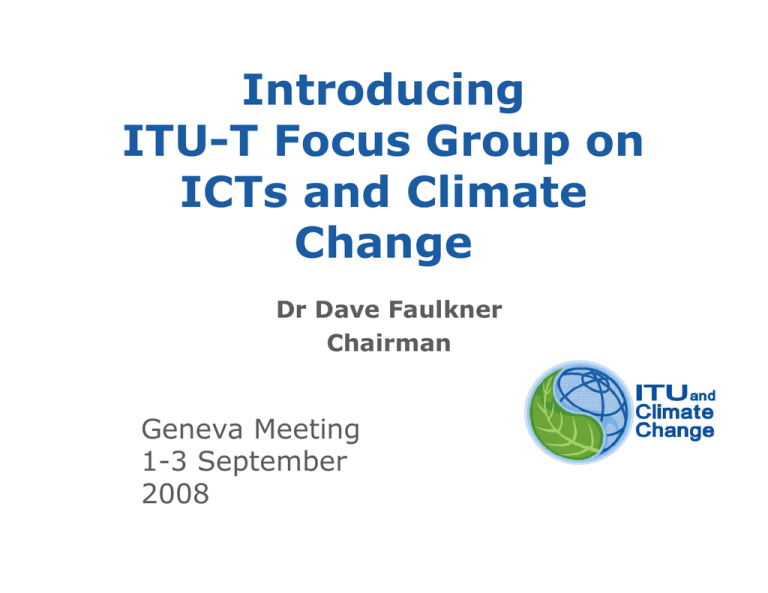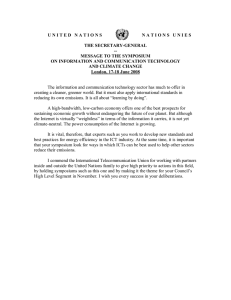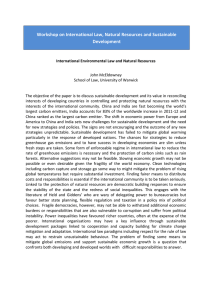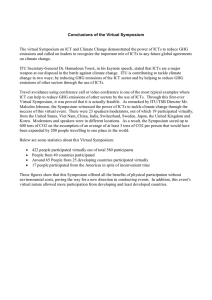Introducing ITU-T Focus Group on ICTs and Climate Change
advertisement

Introducing ITU-T Focus Group on ICTs and Climate Change Dr Dave Faulkner Chairman Geneva Meeting 1-3 September 2008 International Telecommunication Union Contents and Objectives of this Presentation Remind you of risks facing our climate through uncontrolled emissions Consider the link to Peak Oil and the need reduce demand on fossil fuel Stress the need for an economic route forward Encourage you to get involved in meeting the objectives of this Focus Group 2 Evidence for Climate Change #1 WMO World Weather Watch, incorporating: ¾ Global Observing system ¾ Global Telecom System ¾ Global Data Processing system Remote sensing Environmental monitoring ¾ Tsunami early-warning system ¾ Satellite soundings of sea level Digital climate forecasting models GPS-enabled telemetry Ubiquitous sensor networks Essential for accurate forecasting 3 Evidence for climate change #2 Source: IPCC 4th assessment report, 2007 4 Evidence for Climate Change#3 Greenhouse gases (GHGs) are present in the earth's atmosphere which warm near-surface temperatures through the “greenhouse effect” ¾ GHGs, such as CO2 pass incoming high frequency radiation from sun (visible region) but block outgoing emissions from earth (Infrared region) ¾ This process is essential to maintaining the temperature of the Earth at a habitable level However, an excess of GHGs can raise the temperature of a planet to uncontrolled levels ¾ Other gases such as water vapour amplify the greenhouse effect by 36-70% ¾ Clouds typically affect climate differently from other forms of atmospheric water* The effect of cirrus cloud arising from methane and aviation is poorly understood (IPCC) but does contribute to warming Cirrus could be more correctly described as “greenhouse effect” having a distinct layer in the tropopause Atmospheric warming is delayed by the oceans which absorb heat and CO2 ¾ “ The oceans are crucial because they store so much heat” ¾ The specific heat of water is 1000 times higher than air by volume** ¾ 92% of annual emissions could be absorbed into the oceans*** *http://en.wikipedia.org/wiki/Greenhouse_gas ** New Scientist 16 August 2008 p27 *** http://www.john-daly.com/co2-conc/ahl-co2.htm 5 Evidence for Climate Change#4 Based on ice-core samples current levels of CO2 are approximately 46% higher than during immediately pre-industrial times* The energy sector has the greatest potential contribution to GHG emissions ¾ typically contributes over 90% of the CO2 emissions (nuclear and renewables reduce this) ¾ 75 percent of the total greenhouse gas emissions in developed countries** ICTs are a small but significant user of this energy ¾ Every Watt used typically wastes another Watt in inefficiencies in the power generation and transmission *http://www.ipcc-nggip.iges.or.jp/public/2006gl/index.html **2006 IPCC Guidelines for National Greenhouse Gas Inventories 6 GHG Saving-Why do we Care? #1 The Fourth IPCC Assessment Report has proposed a reduction of GHG emissions of 25-40 per cent below 1990 levels by the year 2020 ¾ This could be sufficient to keep the average global temperature rise below 2°C ¾ Even this may be insufficient to keep food production at current levels when regional and local climate variations are included 7 GHG Saving-Why do we Care? #2 The risk of runaway global warming is not as distant a threat as we may wish* ¾ Positive feedback from melting permafrost could make warming irreversible ¾ The amount of carbon stored in the organic matter of arctic permafrost is staggering. Between 750 billion and 950 billion tonnes of organic carbon are thought to be locked in permafrost. There are some 750 billion tonnes of organic carbon in the atmosphere today ** ¾ 27GT are added every year *** from fossil fuel ¾ Dr. Hansen has said that a global tipping point will be reached by 2016 if levels of greenhouse gases like methane and carbon dioxide are not reduced We must act now in telecommunications reduce our emissions along with other sectors to minimise this risk *http://www.ens-newswire.com/ens/jun2007/2007-06-01-01.asp **www.unep.org/geo/yearbook/yb2008/report/Emerging.pdf ***http://en.wikipedia.org/wiki/List_of_countries_by_carbon_dioxide_emissions. 8 Climate Change, Peak Oil and Peak Coal The good news for the climate (bad news for petrol-heads) ¾ Oil cannot be extracted any faster* ¾ If it were down to oil alone, emissions would be capped at present levels and start to decrease The bad news for climate ¾ Oil reserves could last up to 100 years ¾ Coal will be used as an alternative wherever possible ¾ Coal may not peak until around 2032** The OECD Working Party on the Information Economy proposed that work be undertaken to minimise the economic impacts of rising global energy costs*** ¾ The OECD is examining the impacts of ICTs on the environment and identifying the policy implications of achieving environmental goals in an era of climate change and rising global energy costs, *** *http://www.energybulletin.net/4716.html **http://www.fromthewilderness.com/free/ww3/072004_global_climate3.shtml ***http://www.oecd.org/dataoecd/49/28/40839436.pdf 9 ICTs as part of the problem ICTs (excluding broadcasting) contribute an estimated 2% of global Greenhouse Gas emissions Around 0.9 GtCO2e in 2007 Telecoms contributed around one quarter of this total (0.5%) Source: Gartner Group (2007)* * Rakesh Kumar and Lars Mieritz, “Conceptualising ‘Green IT’ and Datacentre Powering and Cooling Issues”, Gartner Research paper ID number G00150322, 7 Sept 2007. 10 ICTs are set to grow Source: Lynn Hutcheson - Ovum www.Ovum.com DSL and FTTP are within scope of ITU-T/SG15 And will double over the next 5 years 11 A Broadband Dilemma Demand is expected to double in 5 years Yet we need to cap emissions Legacy equipment has a typical life of 6-13 years New and replacement technologies are required with much lower energy demand ¾ More than 50% reduction of energy consumption ¾ Must take advantage of low duty-cycle and standby modes 12 Reducing the negative impact of ICTs#1 Directly, e.g., through energy-saving ¾ Next-Generation Networks (NGN) should reduce GHG emissions by 40% ¾ Fewer transport platforms ¾ More efficient access and wireless base stations ¾ Hands-off maintenance avoiding “truck rolls” Indirectly, e.g. ICTs for carbon abatement ¾ Video-conferencing could reduce business travel in Europe by 1%, saving 1Mt CO2 ¾ “Dematerialization” –moving bits not atoms e.g. content delivered electronically-no Paper or CD/DVD Needs more analysis 13 Reducing the negative impact of ICTs#2 ETNO, Europe’s telecoms network operators, reduced their overall CO2 emissions by 7% during the 2002-2004 period* BT Conferencing saved 98kt emissions through 840k meetings in 2007** NTT’s “Total Power Revolution” saved 124m kWh in 2007 Other initiatives are in progress: ¾ GeSI, Green Grid, WattWatt, FTTH Council Europe, EU codes of conduct, CBI Task Force etc. ITU needs to tap into these activities and step up savings in our own telecommunication technologies *http://www.etno.be/Default.aspx?tabid=1524 **http://www.youtube.com/watch?v=NT1aHEnan6U ***http://www.ntt.co.jp/csr_e/2007report/ecology/04.html 14 What is the Economic background to ICT and Climate Change? #1 An economic way forward is needed for the output of the FG to be readily taken up ¾ (Nothing will change otherwise!) ¾ ICT is part of the problem and part of the solution ¾ Saving fuel costs (direct) and efficiency improvements (indirect) are huge incentives The GeSI “SMART 2020” review says ¾ “Companies that implement the solutions will capture part of the potential global savings of $946.5 billion, once again showing that tackling climate change is not only good for the climate but good for the economy” ICT businesses promote these savings with carbon impact assessments ¾ Proposed solutions involve ICTs ¾ Can this FG make these assessments more realistic and widen the benefits with better technology solutions? 15 What is the Economic background to ICT and Climate Change?#2 GDP grows via ¾ increasing population ¾ production with “added value” ICTs are the “information economy” The “Stern Review” (Oct 2006) says* ¾ “A 2 to 3 degrees rise in temperatures could reduce global economic output by 3%” ¾ “emissions need to stabilise in the next 20 years and fall between 1% and 3% after that” ¾ The impact on standard of living is slight *The Stern Review at a Glance http://news.bbc.co.uk/1/hi/business/6098362.stm 16 Global Emissions by Sector Note: The 3% due to ICTs is embedded here (Methane) (fertiliser NOx, methane) (deforestation) *The Stern Review Chapter 7 http://www.hm-treasury.gov.uk/independent_reviews/stern_review_economics_climate_change/sternreview_index.cfm 17 FG Objectives “The FG should analyze and identify gaps in the areas of definitions, general principles, methodology and appropriate tools to characterize the impact of ICTs on Climate Change and support the development of appropriate international standards”* The Focus Group will be identifying ¾ the impact of ICTs on Climate Change over its entire Lifecycle ¾ mitigation measures to be recommended when using ICTs in a relevant sectors ¾ Possible enhancements to monitoring of relevant climate parameters* And reduce fossil fuel dependence ¾ Saving cost and freeing up funds for better use ¾ Monitoring pollution levels and bringing them under control TSAG, TD 673 , Geneva, 2-9 July 2008 18






